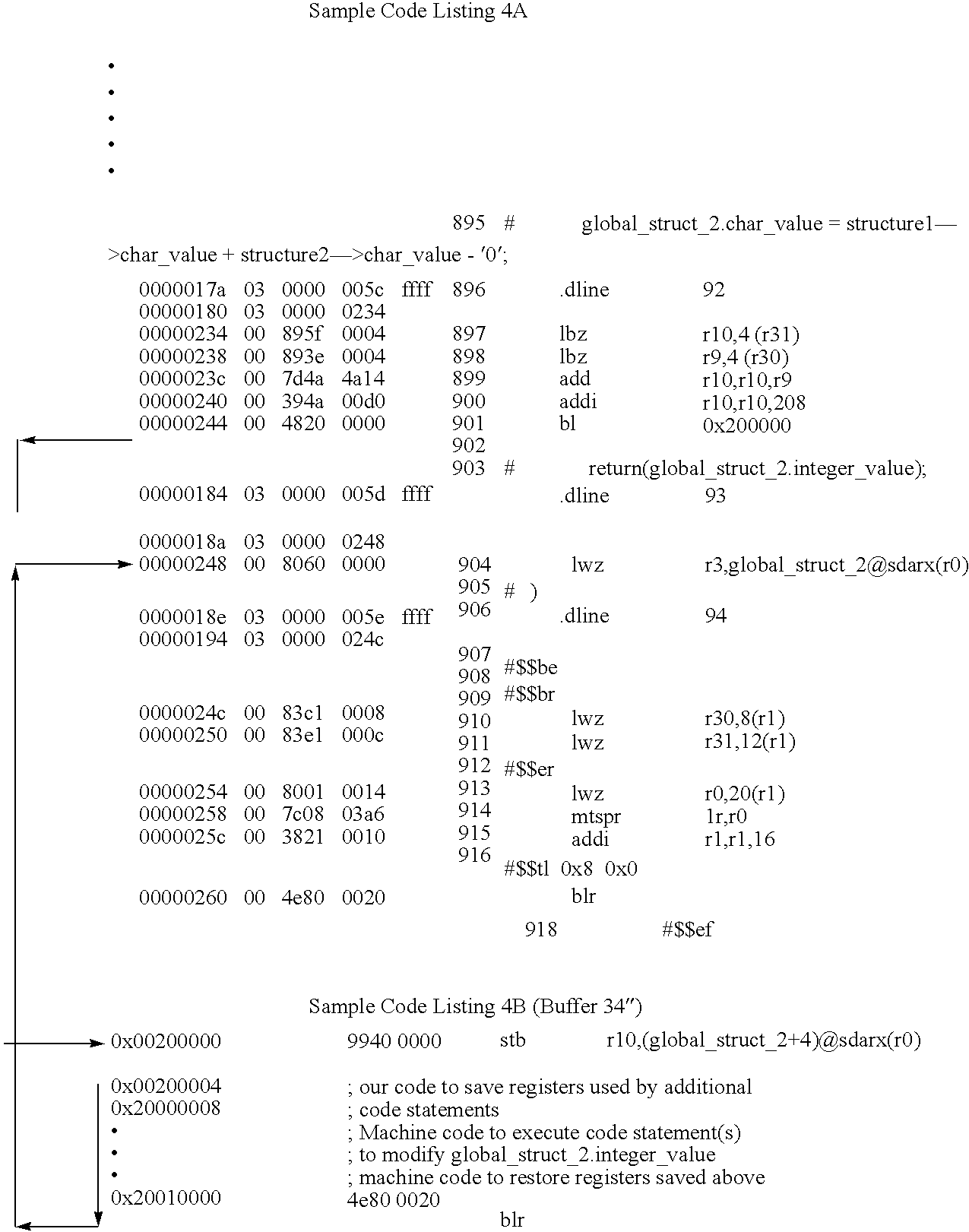Dynamic software code instrumentation method and system
a software code and instrumentation method technology, applied in the field of software analysis, can solve the problems of not being easily usable in connection with processors not originally manufactured with integrated debugging capabilities, increasing the number of executable lines of code, and increasing the size of code in proportion to the number of functions
- Summary
- Abstract
- Description
- Claims
- Application Information
AI Technical Summary
Problems solved by technology
Method used
Image
Examples
example 1
[0067] This example describes the "code insertion" instrumentation behavior of step 3 of Table 4 above. This example examined a function such as "add values reference" that receives pointers to structures and adds their values together returning them in a global structure. In the event this function appears to be operating incorrectly, the "patch" or "code insertion" feature (step 3) of Table 4 may be used to dynamically insert code to monitor (e.g., by a "printf" statement 97 that outputs the values to buffer 103), or code to alter behavior (such as forcing a known value into a variable). For simplicity, in this example, "add_values_reference" performs only an assignment. Sample code used in this Example 1 is shown as "Sample Code Listing 1" hereinbelow.
7 Sample Code Listing 1: int add_values_reference(MY-_STRUCT *structure1, MY_STRUCT *structure2) { global_struct_2.integer_value = structure1->integer_value + structure2->integer_value; global_struct_2.char_value = structure1->char_...
example 2
[0071] The sample code of Example 1 may be instrumented to force a value (Step 5 of Table 4 and the steps of Table 5 hereinabove) to a variable after it was modified by normal program flow. In this example, step 2 of Table 5 adds a "global_struct.sub.--2.integer_value=10" to force "global_struct.sub.--2.integer_" to a value of 10 after it was modified by normal program flow. This generates a change (relative to the Sample Code Listing 1) in the machine code in memory at line 244, as shown in Sample Code Listing 4A below. As shown, the original instruction at line 244 has been replaced with a program flow change instruction 30'" branching 90' (FIG. 14) execution to the scratchpad buffer 34" shown in Sample Code Listing 4B. The code in the buffer 34" effects the desired data manipulation (i.e., forcing the value to 10), and branches execution back to line 248. Line 248 line is thus effectively changed since this instruction places the forced value into register r3 as shown.
10 3
[0072] ...
example 3
[0074] In this example, the "data capture" instrumentation behavior (e.g., function 3 of Table 4) is described with reference to the functions "reference_function" and "value_function". These functions both use the global parameter `global_struct.sub.--1`, shown with arrows "-->" in Sample Code Listing 5A below.
11 Sample Code Listing 5A Original source code: MY_STRUCT reference_function(int *parameter1, char *parameter2) { MY_STRUCT local_struct; local_struct.integer_value = *parameter1; local_struct.char_value = *parameter2; 4 global_struct_1.integer_value = *parameter1; return(local_struct); } MY_STRUCT value_function(int parameter1, char parameter2) { MY_STRUCT local_struct; local_struct.integer_value = parameter1; local_struct.char_value = parameter2; 5 global_struct_1 = local_struct; return (local_struct); }
[0075] In order to capture all modifications to "global_struct.sub.--1", instrumentation module 12' analyzes the symbol table (e.g., generated during compiling the original ...
PUM
 Login to View More
Login to View More Abstract
Description
Claims
Application Information
 Login to View More
Login to View More - R&D
- Intellectual Property
- Life Sciences
- Materials
- Tech Scout
- Unparalleled Data Quality
- Higher Quality Content
- 60% Fewer Hallucinations
Browse by: Latest US Patents, China's latest patents, Technical Efficacy Thesaurus, Application Domain, Technology Topic, Popular Technical Reports.
© 2025 PatSnap. All rights reserved.Legal|Privacy policy|Modern Slavery Act Transparency Statement|Sitemap|About US| Contact US: help@patsnap.com



